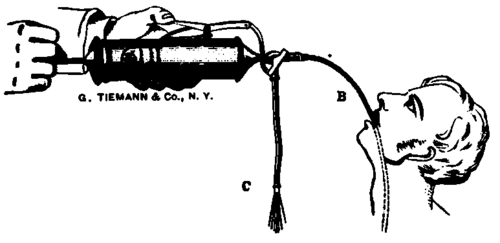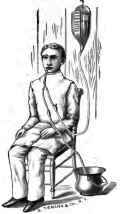Chapter IV. Local Treatment Of The Stomach. 1. Lavage
Description
This section is from the book "Diseases Of The Stomach", by Max Einhorn. Also available from Amazon: Diseases of the Stomach.
Chapter IV. Local Treatment Of The Stomach. 1. Lavage
Gastric lavage, which is so frequently employed in the treatment of diseases of the stomach at the present day, was first introduced by Kussmaul 1 in 1867, who used for this purpose the stomach pump. Previous to that time this method had been practised by Bush, Arnott, Sommerville, and Blutin,2 but to Kussmaul belongs the credit of employing it in a rational and scientific manner. The illustration (Fig. 40) affords an idea of the mechanism of the instrument employed by the latter observer which, however, is now only of historical interest, since it has been supplanted by simpler apparatuses based upon the principle of siphonage.
(A) Funnel Arrangement
The one that is most commonly in use consists of a glass funnel attached to a piece of soft-rubber tubing of about one yard in length which can be slipped over the upper end (connecting glass tube) of the stomach tube. By filling the funnel with water, and alternately raising and lowering the same, the stomach may be filled or emptied. The funnel, as a rule, is not very large and has a capacity of about 300 to 500 c.c. Ewald' advises the use of a very large funnel of about two quarts capacity. This rests in a wooden frame on the floor and after being filled with the requisite amount of water is then raised to a height suitable to obtain the amount of pressure desired. The water escapes from the various openings in the tube as from a sprinkler, and the stomach is in this way irrigated. To siphon the water out of the stomach, the funnel is again placed in the wooden frame, and thus the fluids of the stomach return. Here the whole quantity of the wash-water can be easily inspected.
1 Kussmaul: "Ueber die Behandlung der Magenerweiterung durch eine neue Methode mittelst der Magenpumpe." Deuteches Archiv f. klin. Med., vol. vi., p. 455.
2 See Ewald: "The Diseases of the Stomach," New York, 1892, p. 5.

Fig. 40. - Kussmaul's Stomach Pump.
(B) Leube-Rosenthal Apparatus
The raising of the big funnel is quite troublesome, and I therefore prefer to use in my own practice the Leube-Rosenthal apparatus which I consider the best means of washing out the stomach (see Fig. 4:1). This consists of a large glass irrigator of about two to three quarts capacity. Leading from the irrigator a large piece of soft-rubber tube is connected by means of a Y-shaped glass tube first with the stomach tube, secondly, with another quite long piece of soft-rubber tubing. Both arms of tubing, the one running from the irrigator the other into a waste vessel, are provided with clamps. By opening the clamp on the irrigator tubing, the water runs into the stomach. By closing the same and opening the tube running to the waste vessel, the water is withdrawn from the stomach. The amount of water which is used for each single filling of the stomach may vary from 400 c.c. to a litre. The stomach may be filled with water so long as the patient does not experience any pressure. As soon as he begins to feel some pressure, the quantity should not be increased, but at once withdrawn. This man-ceuvre can be repeated twice or three times at each sitting.
In case large quantities of mucus are present in the wash-water, it is best to have the patient shake himself, especially his abdomen, while the water is entering the stomach. In this way it is possible to mechanically clean the organ much more thoroughly than would otherwise be the case. The same method of shaking has to be applied if the stomach contains some food.
1 C. A. Ewald. l. a. p. 64.

Fig. 41 .Leubo-Rosenthal Apparatus for Gastric Lavage.
The advantages of this apparatus are quite mani fold:
1. The ease with which the whole procedure can be executed.
2. The water introduced into the stomach is always clear, as the waste water passes through a separate tube; while in the use of the funnel arrangement after the first filling the funnel and the tubing become soiled during the withdrawal of the contents, and in consequence of this, during the second filling, much of the mucus which has remained within the apparatus returns to the stomach.
Continue to:


